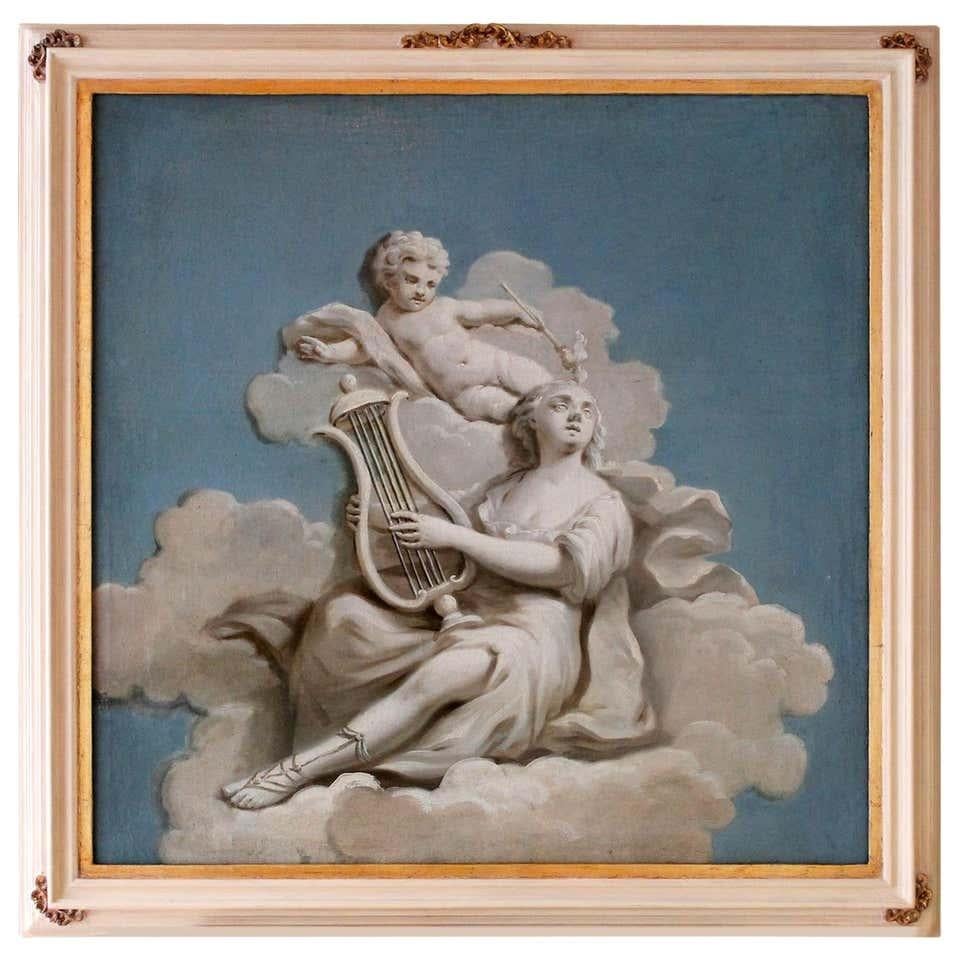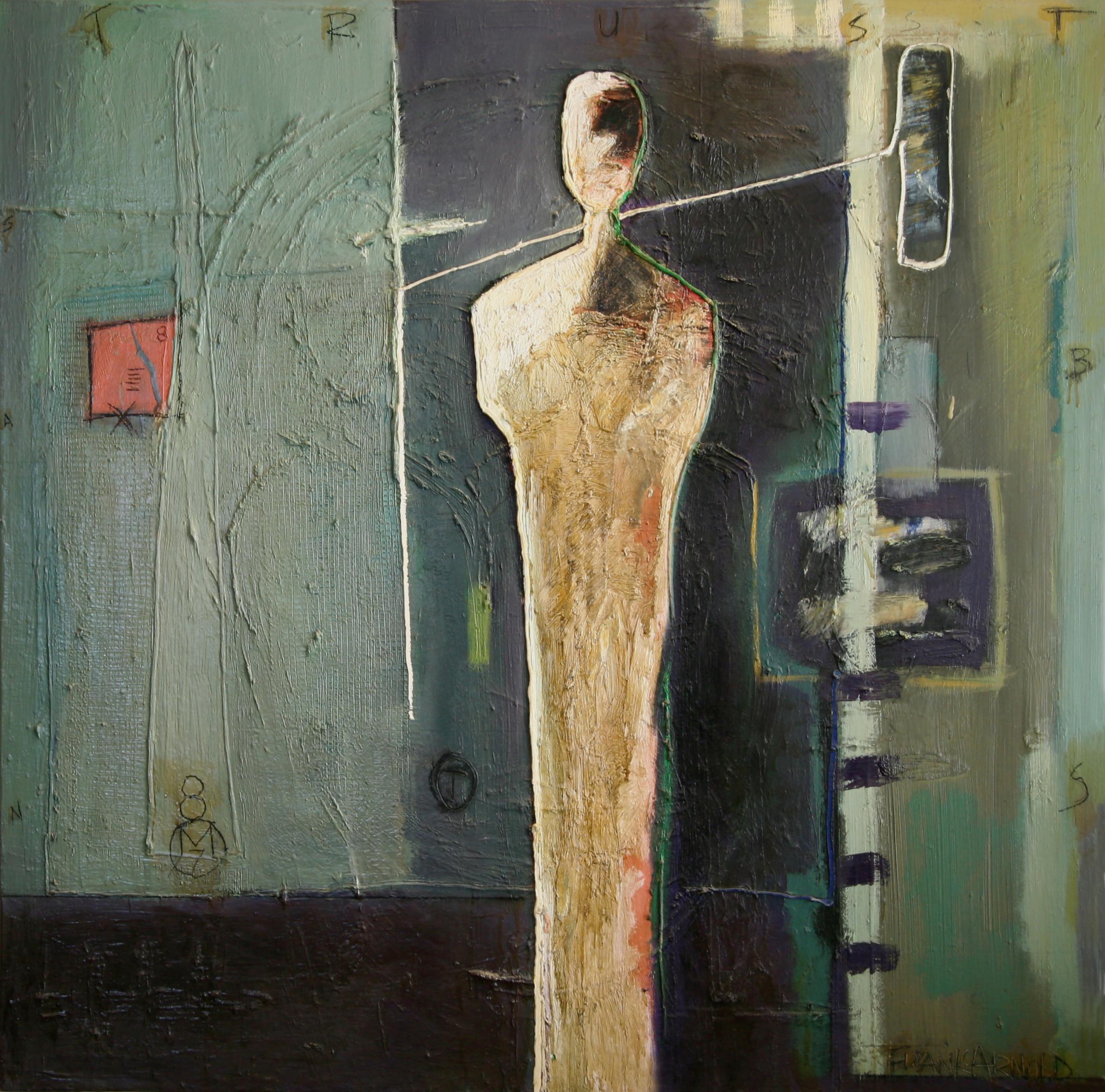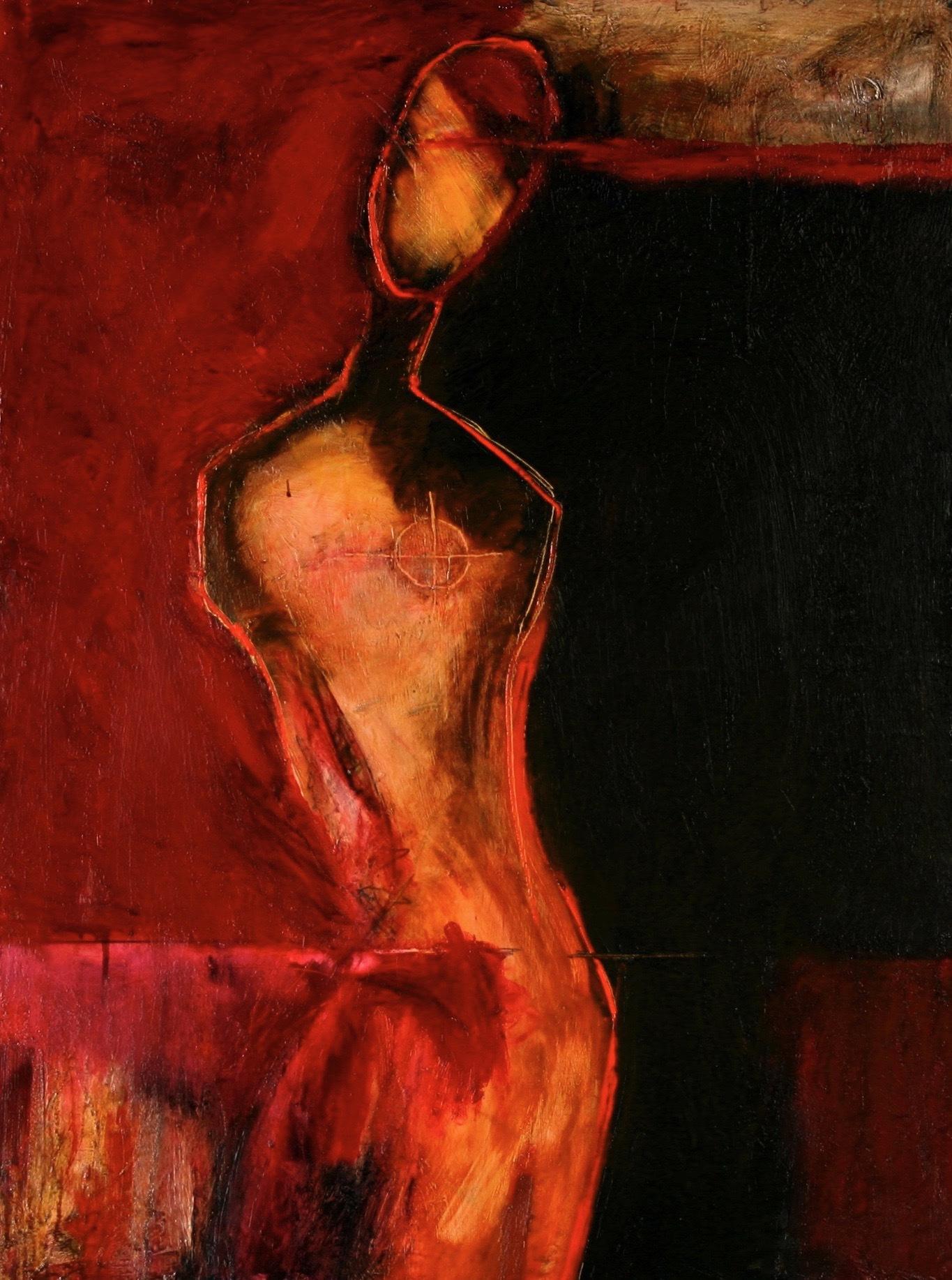Items Similar to Immaculate Madonna within garland painting Giovanni Stanchi and Girolamo Pesci
Want more images or videos?
Request additional images or videos from the seller
1 of 23
Giovanni StanchiImmaculate Madonna within garland painting Giovanni Stanchi and Girolamo Pesci
About the Item
Giovanni Stanchi (Rome, 1608 - 1675) and Girolamo Pesci ( Rome 1679 - 1759)
Immaculate Madonna within floral garland
Oil on canvas, cm 95 x 72
Frame, cm 106 x 83
Expert opinion of Prof. Emilio Negro
The present painting is the result of a happy collaboration between two painters: the first author of the religious image, the other of the garland of fresh flowers, the real star of the painting. The figure depicted is an Immaculate Conception, the dogma, that is, the truth of faith, whereby Our Lady was "untouched" by original sin, she was preserved by it from the first moment of her conception. In the center of the composition therefore, Our Lady is surrounded by golden clouds and enveloped in a divine light; clad in a white robe and blue mantle, she opens her arms in prayer, offering her eyes toward heaven while resting her feet on a half-moon, an iconographic symbol often found in Immaculate Conceptions. Along with her are a pair of angels and a pair of cherubim. The figure by stylistic references can be related to the hand of the painter Girolamo Pesci (Rome 1679 - 1759) who became a member of the prestigious congregation of Roman painters called de Virtuosi al Pantheon" managed to distinguish himself among the exponents of the school of Maratta. He was later seduced by Trevisani's style, which would mark his art in lightness, expressive delicacy, and a distinct taste for shaded and pearly colors-a deference to the Venetian colorism typical of Trevisani. This Immaculate Conception may in fact be related to the Eucharist of the Virgin from the Church of St. Joseph at the Lungara, the Ecstasy of St. Francis from the Civic Museum in Rieti, but also the Ascension of the Virgin from the Church of St. Mary Magdalene in Rome.
Instead, the garland is without any doubt attributable to the hand of Roman painter Giovanni Stanchi (Rome, 1608 - 1675). The author, who distinguished himself among the best naturamortists active in Rome during the Baroque age, founded a workshop in which his brothers Angelo and Nicolò would work, demonstrating a synergy of purpose and an extraordinary consistency of quality.
The Stanchi and their paintings were sought after by the most important families of the Roman aristocracy, from the Colonna to the Chigi to the Rospigliosi, and present since the end of the century in the Medici collections. Extremely varied in type but stylistically consistent, the production of the Stanchi can be divided according to the subjects proposed: first of all, the garlands, of which the proposed canvas is a fine example, related to the Flemish model made famous in Rome by Daniel Seghers, and probably largely referable to Giovanni. In particular, the present one can be related to the Vase of Flowers, Putti and Little Bird and the Garland of Flowers of Palazzo Colonna (paintings on mirror whose figures are made by Carlo Maratta), the Garland of Flowers and Butterflies of the Pinacoteca Nazionale di Bologna and the Still Life with Glass Ampoule and Fruit Basket of Galleria Pallavicini but also the festoon of flowers of the Musée des Beaux-Arts, Nantes and the garland of the Museum of Still Life of Poggio a Caiano
In these paintings there is the same bright and whimsical painting, made by strokes of light, characteristic of paintings executed in the years of the master's full artistic maturity.
Among the flowers represented are tulips, roses, and anemones that seem to have symbolic meaning: they are metaphors for the transience of life and earthly beauty, which, like flowers, wither slowly.
- Creator:Giovanni Stanchi (1608 - 1675, Italian)
- Dimensions:Height: 41.74 in (106 cm)Width: 32.68 in (83 cm)
- Medium:
- Period:
- Condition:
- Gallery Location:Milan, IT
- Reference Number:1stDibs: LU2639213034372
About the Seller
No Reviews Yet
Vetted Seller
These experienced sellers undergo a comprehensive evaluation by our team of in-house experts.
1stDibs seller since 2023
- ShippingRetrieving quote...Ships From: Milan, Italy
- Return PolicyA return for this item may be initiated within 14 days of delivery.
More From This SellerView All
- Battle scene Oil painting on canvas Attributed to Karel BreydelBy Karel BreydelLocated in Milan, ITAttr. to Karel Breydel, known as the Knight of Antwerp (1678 - 1733) Battle with knights and landscape in the background Oil on canvas, cm 44.5 X 36.7 Frame 52.5 x 45 cm The pain...Category
Late 18th Century Figurative Paintings
MaterialsCanvas, Paint, Oil
- Still life with fruits on a shelf Oil painting on canvas Paolo PaolettiLocated in Milan, ITPaolo Paoletti (Padua, 1671 - Udine, 1735) Still life with fruits on a shelf Oil on canvas, 53.5 x 81 cm Expert opinion Dr. Gianluca Bocchi The still life under consideration can...Category
18th Century Figurative Paintings
MaterialsCanvas, Paint, Oil
- Presentation of Mary in the Temple Oil on canvas Scope of Pietro BardellinoBy Pietro BardellinoLocated in Milan, ITScope of Pietro Bardellino (1728-1806), circa 1760s Presentation of Mary in the Temple Oil on canvas, 163 x 150 cm With frame, cm 166 x 152 Dealt with in the proto-gospel of James, an apocryphal gospel, Mary's presentation to the temple remains to this day one of the most moving Marian artistic episodes. The moment figured here, in which the little Virgin is encouraged to the high priest by her nobly determined mother Anna, encapsulates a composition harmoniously cradled between Baroque and Classicism. All present turned in amazement to observe the young woman's unexpected entry into the sacred premises, while a direct light detached her figure from the soft incensed air. This strong expressive naturalness, added to the clear formal concreteness used by the artist, intoxicates the painting with the academicism already belonging to Francesco Solimena and Giacomo del Po, on a par with the greatest Neapolitan masters. The thoughtful consistency with which the artist organizes the luminous and tangible colors also formalizes his dependence on Pietro Bardellino, a distinguished exponent of the first Rococo investigations on Neapolitan soil. Committed from his youth to the great hall of the Farmacia degli Incurabili, Bardellino turned to the Oratory of the Confraternity of the Whites of the Holy Spirit, working at the same time for Bitonto Cathedral. Appointed a member of the Academy of Fine Arts, he was recalled there as an active collaborator by Vanvitelli himself, in 1773. A debtor in turn to the style of Francesco de Mura, his master, by the mid-18th century Bardellino was already registered as a fresco painter at the main royal residences of Ferdinand IV of Bourbon, reaching the pinnacle of his success there in 1781 with the commission to fresco The Virtues Crowning Ferdinand IV and Maria Carolina on the huge ceiling of the Grand Hall of the Palazzo dei Regi Studi in Naples (later to become the Royal Bourbon Museum used in our days as the National Archaeological Museum of Naples). This evidence allowed him to become a master in the technique of fresco painting, boasted therefore at several noble residences, among the interiors of which it is possible to recall those of Cellamare, Ischitella and Spinelli di Fuscaldo. A coloristic lucidity, similar to that which shines in the present, returns in Bardellino's late works, now exhibited in the old apartment of the Reggia di Caserta (Science and the Arts, Peace and War, Innocence, Simplicity, Truth, Day and Night), albeit colder, due to the artist's adoption of the northern European art trends fashionable at the court of the Bourbon consort Maria Carolina, also influencing Corrado Giaquinto...Category
18th Century and Earlier Figurative Paintings
MaterialsCanvas, Paint, Oil
- Jacob's departure for the land of Canaan Canvas from the Grechetto WorkshopLocated in Milan, ITWorkshop of Gio Benedetto Castiglione called the Grechetto (Genoa, March 23, 1609 - Mantua, May 5, 1664) Jacob's departure for the land of Canaan Oil on canvas, 80 x 115 cm - Fra...Category
17th Century Figurative Paintings
MaterialsOil, Canvas
- Game of bowls Oil painting on canvas by Domenico OliveroLocated in Milan, ITDomenico Olivero (Turin, August 1, 1679 - January 13, 1755) Game of bowls Oil on canvas, 43 x 65 cm With frame, 54.5 x 76 Expert opinion Prof. Alberto Crispo The painting shown here depicts peasants playing bowls near a farmhouse, while one of them offers sweets to a little girl. The canvas, in my opinion, can be traced back to the hand of Pietro Domenico Olivero (Turin, August 1, 1679 - January 13, 1755), as revealed by comparisons with other works by the artist, such as the Peasants' Feast already at the Gilberto Zabert Gallery in Turin, where we find an entirely similar layout, with the figures crowded around the building, placed on the left, and some household goods piled up on the right, including a copper cauldron almost identical to the one sketched in our painting. But see also other similar subjects painted by the Turin-based artist, such as the Game of Bowls already at the Cantore Gallery in Modena or the other version on the Genoese market in 2019, which, although radically different compositionally, confirm the painter's interest in playful themes and manifest the same ways in delineating characters, with synthetic and robust brushstrokes. The artist was born in Turin, in the parish of St. Thomas, on August 1, 1679 to Giovanna and Francesco, a carver by profession. He trained at the workshop of the painter and architect Melchiorre Baldassarre Bianco. He was esteemed by Victor Amadeus II of Savoy, who commissioned paintings for the Venaria Reale (1714), the Royal Palace of Turin (1716), and Rivoli Castle (1724), as well as by his ministers Pietro Mellarède and Carlo Vincenzo Ferrero di Roasio marquis of Ormea whose collections counted many of the painter's works. His success on the Turin art scene earned him election as prior of the Accademia di San Luca in Turin (1726). In 1731 he painted the eleven canvases with Stories of Franciscan Saints in the sacristy of the church of St. Thomas in Turin, while in 1734 he made the Marriage at Cana for the sanctuary of Oropa. The Savoy commissions continued with the ten canvases executed for the castle of Agliè (1737), the decoration of the third room of the New Archives in the Royal Palace of Turin (1739-41), and the thirty or so works for the hunting lodge at Stupinigi (1748-51). The painter also measured himself in designing sets for the Teatro Regio in Turin (1745-46). He made his will on November 15, 1754, and died in his hometown on January 13, 1755. Olivero's genre scenes, such as the one commented on here, reveal a focus on Flemish painting, particularly by David Teniers the Younger, Peter Mauritz Bolckman, Theodor Helmbreker, and Cornelis de Wael, as well as Roman bamboozlers such as Pieter van Laer, Michelangelo Cerquozzi, and Jan Miel...Category
18th Century Figurative Paintings
MaterialsCanvas, Paint, Oil
- Rest during the flight into Egypt Oil painting on canvas Giuseppe RoncelliLocated in Milan, ITGiuseppe Roncelli (Candia, 1663 - Bergamo, 1729) Rest on the Flight into Egypt Oil on canvas, 55 x 45.5 cm With Frame, 65 x 77 cm The painting under consideration, by Giuseppe Ro...Category
Late 17th Century Figurative Paintings
MaterialsCanvas, Paint, Oil
You May Also Like
- French 19th Century Oil on Canvas Blue and White Music Allegory Cherub PaintingLocated in Firenze, ITThis romantic French 19th century allegoric oil painting on square canvas has a sky blue background, a fluffy cloud fills the central part of the painting where a woman is lying down playing the lyre, while a graceful cherub seems to twirl over her. This oil on canvas painting represents the allegory of music - with a woman dressed in classical clothes and a putto- a very popular theme during all the neoclassical age, with its lively scene inspired by the Rococo period. The composition creates a awesome trompe-l'œil effect thanks to the color palette scheme. Well painted white and gray shadings (chiaro scuro) that stands out from the light blue background in typical grisaille style. This painting originally was an over door frieze...Category
19th Century Rococo Figurative Paintings
MaterialsCanvas, Oil
- Italian Oil on Canvas Painting Coat of Arms in Gold Leaves Panel and Black FrameLocated in Firenze, ITThis huge Italian 19th century armorial painting features the coat of arms of Montini, a noble Italian family that has among its ancestors the Archbishop of Milan, later known as Pope Paul VI. The large oval canvas has a brown and red background, the latter shaped like a shield, in which six mountains (from the etymology of the surname) and three white fleur de lis are painted. This big scale palatial oil painting...Category
Late 19th Century Italian School Figurative Paintings
MaterialsOil, Canvas, Wood
- Oil on Canvas “BS Trust”By Frank ArnoldLocated in Fresno, CA“BS Trust” is 36” x 36”. Frank Arnold’s paintings exhibit the highest quality materials for a truly archival piece, created to last generations. Much of Frank Arnold’s work is sourc...Category
2010s Abstract Abstract Paintings
MaterialsCanvas, Oil
- Last DanceBy Frank ArnoldLocated in Fresno, CALast Dance is an Oil on Canvas painting in soft, light aqua tones with red/brown accents. Frank Arnold is thought by many to be one of the foremost abstract...Category
2010s Abstract Abstract Paintings
MaterialsCanvas, Oil
- My Other SideBy Frank ArnoldLocated in Fresno, CA“My Other Side” is 48”x 36”. This is an earlier piece by Arnold from the estate of a late collector of his work. This piece is predominantly shades of red from light to almost black....Category
Early 2000s Abstract Abstract Paintings
MaterialsCanvas, Oil
- New MoveBy Frank ArnoldLocated in Fresno, CA"New Move 8" Oil on Canvas is a mix of blues and greens with chrome yellow accents. Frank Arnold is thought by many to be one of the foremost abstract figurative painters and sculpto...Category
2010s Abstract Abstract Paintings
MaterialsCanvas, Oil




